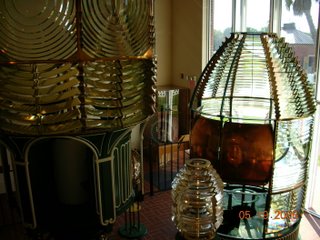 A little information on lighthouses to illuminate your weekend...
A little information on lighthouses to illuminate your weekend...Every lighthouse has a unique light. The lights may be different colors and sizes, flash for a different amounts of time, or remain solid. The light pattern is called the characteristic.
The lights are placed on something that looks like a rotating table; as the light spins to the back of the lighthouse, it gives the appearance of having gone out, or of shutting off. When it circles back around to the front, ships at sea see the "flash" once again. The speed of the flash can be changed by increasing or decreasing the speed of the table's rotation.
As you can see above, lighthouse lights, or lenses, come in a wide variety of sizes. One of the most powerful lenses is the Fresnel lens, invented in 1822 by Augustine Fresnel of France. Looking like a glass beehive, this lens operates by reflecting light from a source (like a candle), focusing it to one spot, and sending out the beam. There are 7 levels, or orders, of Fresnel lenses. The closer the light source, the further the light shines. A beam from an order 1 lens can be seen more than 20 miles away.
Fresnel's design of using concentric glass rings to focus light is still used today in traffic signals, car headlights and projectors. The state with the most lighthouses is Michigan at 130. For some more quick and interesting facts on lighthouses, visit The US Lighthouse Society page.
No comments:
Post a Comment